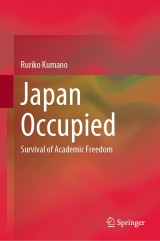Details

Japan Occupied
Survival of Academic Freedom|
117,69 € |
|
| Verlag: | Springer |
| Format: | |
| Veröffentl.: | 28.01.2023 |
| ISBN/EAN: | 9789811985829 |
| Sprache: | englisch |
Dieses eBook enthält ein Wasserzeichen.
Beschreibungen
<p>This book documents Japan's psychological deterioration caused by its defeat in August 1945. Also, Japan’s traumatic transformation from authoritarianism to democracy is detailed.</p>
<p> The study exposes an ideological war between the Soviet Union and the USA within American-occupied Japan, which triggered violent polarization among the Japanese. Under General MacArthur’s tutorage, the defeated Japanese were expected to become a peace-loving people, but the Cold War derailed Japan’s progress toward freedom and democracy. The “Red Purge,” instituted by MacArthur's Headquarters (GHQ) from 1949 to 1950, triggered the devastating side effects on Japan's academic freedom and freedom of speech.</p>
<p> Stanford University Professor Dr. Walter C. Eells (1886–1962) served at the GHQ as an influential education adviser and became the most vocal advocate of the Red Purge. Japanese Marxist historians have constructed the popular postwar narrative of the Red Purge, blaming the GHQ for every failure.</p>
<p> The vast archival materials, including the GHQ papers, Eells papers, and Japanese-language documents, revealed that the Red Purge was a serious propaganda battle between the Americans and the Soviets in a war-torn Japan. This propaganda war engendered the violently polarized political climate, in which the conservative Japanese government behaved according to the dictates of US Cold War policy. By revealing feverish tensions within the GHQ regarding communist influences in Japanese universities, this study sheds bright new light on the Red Purge and its lasting impact on Japan's political future.</p>
<p> The study exposes an ideological war between the Soviet Union and the USA within American-occupied Japan, which triggered violent polarization among the Japanese. Under General MacArthur’s tutorage, the defeated Japanese were expected to become a peace-loving people, but the Cold War derailed Japan’s progress toward freedom and democracy. The “Red Purge,” instituted by MacArthur's Headquarters (GHQ) from 1949 to 1950, triggered the devastating side effects on Japan's academic freedom and freedom of speech.</p>
<p> Stanford University Professor Dr. Walter C. Eells (1886–1962) served at the GHQ as an influential education adviser and became the most vocal advocate of the Red Purge. Japanese Marxist historians have constructed the popular postwar narrative of the Red Purge, blaming the GHQ for every failure.</p>
<p> The vast archival materials, including the GHQ papers, Eells papers, and Japanese-language documents, revealed that the Red Purge was a serious propaganda battle between the Americans and the Soviets in a war-torn Japan. This propaganda war engendered the violently polarized political climate, in which the conservative Japanese government behaved according to the dictates of US Cold War policy. By revealing feverish tensions within the GHQ regarding communist influences in Japanese universities, this study sheds bright new light on the Red Purge and its lasting impact on Japan's political future.</p>
-Preface<p>-Acknowledgments</p><p>-Introduction</p><p>-1. Religion and Education in Prewar Japan: Building a New Identity and Suppressing “Dangerous Thoughts” </p><p>-2. The GHQ’s Initial Reforms: The Dismantling of Japan</p><p>-3<b>.</b><b> </b>General Headquarters (GHQ) vs. the Japanese Communist Party</p><p>-4.<b> </b>University Reform</p><p>-5. Communism in the Universities</p><p>-6. Covert Red Purge in Education</p><p>-7. The Japanese Communists’ Propaganda Attack on the United States</p><p>-8. The Japanese Government Launches the Red Purge</p><p>-9. War of Ideas</p><p>-Conclusion</p><p>-Appendixes</p>-Notes<p></p><p>-Selected Bibliography</p><p>-Index</p>-About the Author
<p>Ruriko Kumano received her PhD in education from the University of Hawaii at Manoa in 2007 and is currently an associate professor in the Faculty of Global Studies at Reitaku University, Japan. Through her graduate studies at Seton Hall University in the United States (MA in Asian Studies) and PhD research at the University of Hawaii (East-West Center full fellowship grantee), she has focused on studying the lost memory of Japan’s pre-war ideology and the drastic reforms under the US occupation to discover the reasons for the downfall of the pre-war regime and why postwar Japanese people are taught so little about the pre-war ideology.</p><p> Her publications include <i>Nihon Kyōiku Senryō</i> (Japanese Education Occupied) (2015) and "Anticommunism and Academic Freedom: Walter C. Eells and the ‘Red Purge’ in Occupied Japan" (in <i>History of Education Quarterly</i>, 50, no. 4, 2010).</p>
This book documents Japan's psychological deterioration caused by its defeat in August 1945. Also, Japan’s traumatic transformation from authoritarianism to democracy is detailed.<p>The study exposes an ideological war between the Soviet Union and the USA within American-occupied Japan, which triggered violent polarization among the Japanese. Under General MacArthur’s tutorage, the defeated Japanese were expected to become a peace-loving people, but the Cold War derailed Japan’s progress toward freedom and democracy. The “Red Purge,” instituted by MacArthur's Headquarters (GHQ) from 1949 to 1950, triggered the devastating side effects on Japan's academic freedom and freedom of speech.</p><p> </p><p>Stanford University Professor Dr. Walter C. Eells (1886–1962) served at the GHQ as an influential education adviser and became the most vocal advocate of the Red Purge. Japanese Marxist historians have constructed the popular postwar narrative of the Red Purge, blaming the GHQ for every failure.</p><p> </p><p>The vast archival materials, including the GHQ papers, Eells papers, and Japanese-language documents, revealed that the Red Purge was a serious propaganda battle between the Americans and the Soviets in a war-torn Japan. This propaganda war engendered the violently polarized political climate, in which the conservative Japanese government behaved according to the dictates of US Cold War policy. By revealing feverish tensions within the GHQ regarding communist influences in Japanese universities, this study sheds bright new light on the Red Purge and its lasting impact on Japan's political future.</p>
<p>Analyzes the American GHQ’s “spiritual disarmament” of defeated Japan</p><p>Explains why Japanese people cannot face the reality of international geopolitics</p><p>Details how the Cold War crippled the growth of freedom of speech in postwar Japan</p>

















